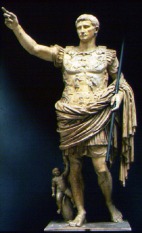The Army of Augustus

The legion of Augustus did not start with Augustus, but really with Julius Caesar. Julius formed a body of professional army machines, but his reign didn't last as long as maybe it should have, therefore Augustus was the one who received the honor of keeping this highly trained military unit in tact and going stronger than before. This was a difficult task that Augustus had to make happen for the safety of the future of Rome. He made his job much easier by establishing the army in a time of peace. So he formed 28 legions of about 6000 men each, which equals about 168,000 soldier. Not too shabby. Another thing Augustus did to ensure the reliance of the safety of Rome, was that he increased the service of a soldier from six years to a twenty year service.
This time of rather significant peace led to rather difficult tasks for the soldiers anyways. A soldier had to rely heavily on his own resources for weeks. The soldiers, obviously would have to carry a lot of things, about 60 lbs of tools, food, clothes, and other personal possessions. The soldiers of Augustus were nicknamed 'Marius Mules', because of the heavy load they had to carry. If you ask me, I would have rather been an aquilifer, a person who held up the aquila, or the eagle, that was the standard of the legion, like the bald eagle is the United States symbol. The aquilifer didn't have to do much but hold up that symbol of the Roman Army.
Other important tasks the army had to work on included that they would need to have more men along the trips to make sure these tasks were completed correctly. One thing the army did was build bridges. So then the army would need engineers to make sure the bridges were being built with exact accuracy. The engineers were known as 'immunes', because they were excused from other duties that the ordinary soldier had to do. Other immunes along on the Roman Legions' trips were medical officers, surveyors, carpenter, veterinaries, hunters, armourers, soothsayers, and priests. In the forts on the frontiers of battle, other non combatants were needed to keep the army in steady use. Scribes and supervisors were in charge of army pay, supplies and customs. And military police were present at the forts.
The structure of the legion itself was rather different than ever before. One legion was made up of ten cohorts, and each cohort was divided up into six centuries of eighty men commanded by a centurion. The entire legion came under the command of a legatus, who would be in command for three to four years, then serve as a governor of some province within Rome. The legatus was like a general, who had a staff of six officers, who could, if necessary lead a group of the legion. So all in all, there were about 6,000 men in one legion, with soldiers and non-combatants.
Centurions had a privilege over their soldiers also within the racks of the army. Instead of having to walk allover the empire on foot, centurions rode on horseback. Centurions could also beat their soldiers, with a wooden, three foot long staff. The staff was one way of identifying a centurion. Centurions also received double the pay than the ordinary soldier. But there were disadvantages to being a centurion as well. A centurion, did not retire from the service, but almost always died in service. That would not have been a life I would have looked forward to.